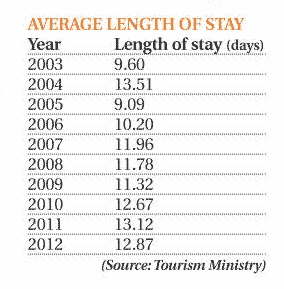

Tourist length of stay down to 12.87 days in 2012

The average length of stay of tourists in Nepal has slipped to 12.87 days in 2012 from 13.12 days in 2011, according to the latest tourism statistics of the Tourism Ministry. Government officials and travel trade entrepreneurs attributed the fall to a shift in the country’s tourism demand to mass tourism, particularly due to higher arrivals from China and India.
The length of stay of Indian tourists is the lowest among the source markets. Chinese visitors are the third shortest stayers. These two regions accounted for 30 percent of the total arrivals to Nepal last year. Nepal received 803,092 tourists in 2012 (598,258 via air and 204,834 via surface route). Of the total arrivals, tourists from India and China numbered 165,139 and 71,380 respectively.
“A significant rise in visitor numbers from the southern and northern neighbours could be the major reason behind the fall in the overall length of stay,” said Rabi Prasad Kayastha, the chief statistician at the ministry. According to Kayastha, visitors from India and China are particularly concentrated in urban areas like Kathmandu and Pokhara, and they spend less time in the country.
Mass tourism generally refers to the transport of large numbers of people in a short space of time to places of leisure interest. According to the ministry, 48 percent of the total arrivals visited Nepal for travel and holidaymaking.
Around 14 percent of the tourists in Nepal went trekking and mountaineering, the segments that require tourists to spend long periods outside Kathmandu. Over 13 percent of the tourists in Nepal last year came for pilgrimage, according to the ministry.
Nepal recorded the highest length of stay of tourists in 1996 which reached 13.50 days. The shortest stay of 7.92 days was recorded in 2002.
“The year 2012 was not a peaceful year for visitors to stay long here due to instability in the country’s politics,” said Hari Sarmah, the CEO of the Nepal Association of Tour and Travel Agents (NATTA). “In fact, there were lots of cancellations of hotel reservations by tourists due to the announcement of a number of strikes last year. And this factor could have resulted in tourists cutting short their visit.” In addition, the tourism packages offered to tourists in Nepal are still traditional, said Sarmah. “There is nothing new to offer the visitors to increase their stay,” he said. It is time to review the traditional way of selling Pokhara and Chitwan among visitors, particularly Indians.
A decline in strikes in 2011, when top political leaders promised not to announce strikes, had a positive impact on Nepal’s tourism. In 2011, the average length of stay increased to a seven-year high of 13.1 days. Meanwhile, the contribution of tourism to the country’s GDP increased to 2.0 percent in 2011-12 from 1.8 percent in 2010-11, according to the ministry. In 2009-10, tourism contributed 2.4 percent. The country received Rs 30.70 billion from the travel sector in 2011-12 against Rs 24.61 billion in 2010-11.
source: the kathmandu post,28 april 2013








